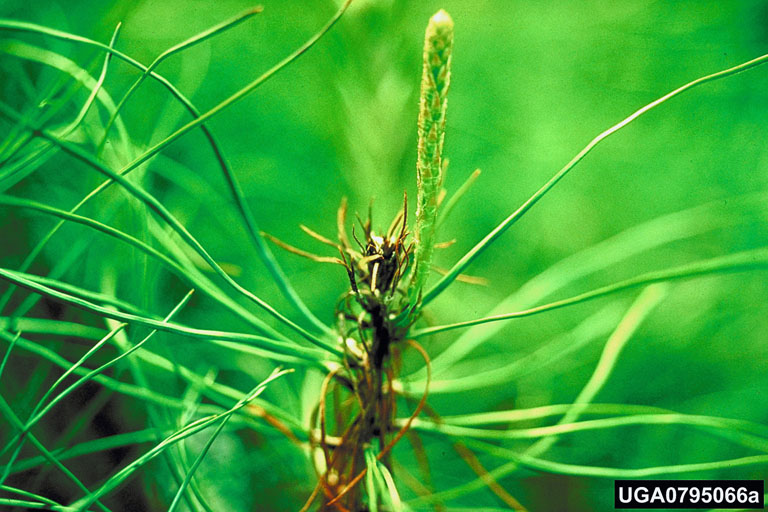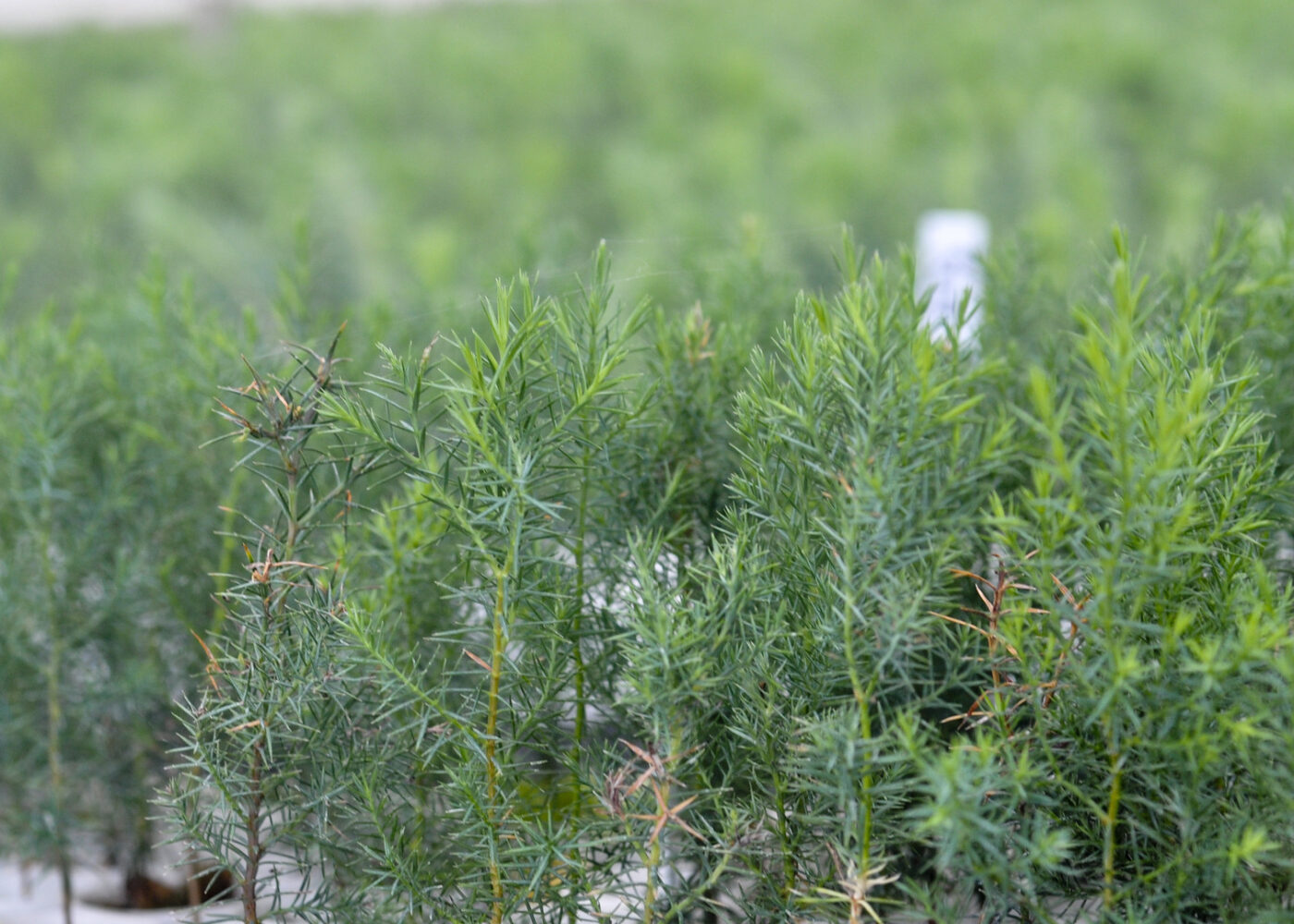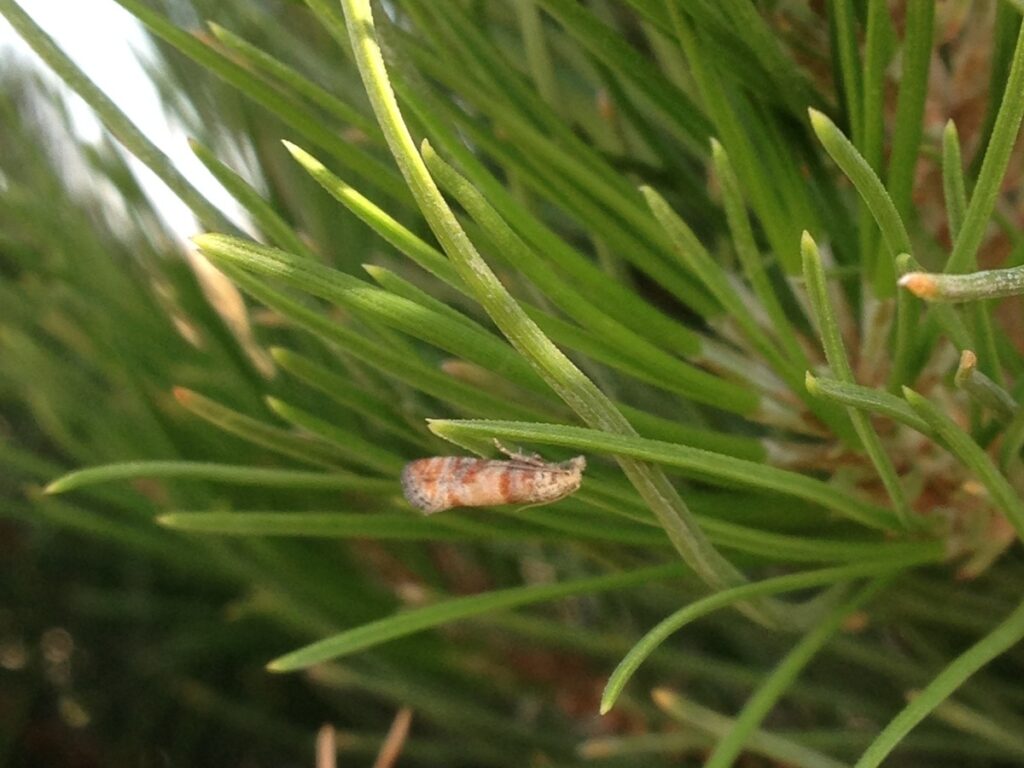Pine tip moth, Rhyacionia spp., is a major forest pest across the U.S.
The Nantucket pine tip moth, R. frustrana, or Comstock, is the most common and economically impactful in the South.
They are most easily identified by the gray scales covering all of their body, except for the forewings, which are covered with brick-red and copper-colored patches separated by irregular bands of gray scales.
The moth can be found as far north as Massachusetts, south as Florida, and west as Texas. It has also been introduced to California, where it is now the key pest of Christmas tree farms.
The primary hosts of the Nantucket pine tip moth in the South and Southeast are yellow pines including loblolly and shortleaf pines. In New England and the Mid-Atlantic, Virginia, pitch, and Scotch pines. And in California, Monterey pine.
While found in the same region as the Nantucket pine tip, slash pine is highly resistant and longleaf pine is virtually immune to attack.
The Nantucket pine tip moth is most damaging to pine plantations and to wild and ornamental pine seedlings in open areas . It poses an ever-increasing problem because of forestry trends that favor the establishment of large areas of pine plantations. Since they thrive in these environments, damage may be very common. Tip moths may also be particularly damaging to pine seed orchards because they kill female flowers and immature pine cones, called “conelets”.
Life cycle
The Nantucket pine tip moth has two to five generations every year.
Their pupae are light to dark brown and about ¼ inch long. The pupae overwinter inside damaged shoots, cones, or buds.
In Southeast Texas, adults emerge from early Feb. to mid-March, synchronized with new growth from its primary host, loblolly pine. Gray scales cover the adult’s head, body, and appendages, except for the forewings, which are covered with brick-red and copper-colored patches separated by irregular bands of gray scales.
Mating occurs soon after emergence and is mediated by sex pheromones, where female-produced chemicals attract males. Eggs are often deposited on needles, and hatch within 14 days. Eggs are slightly convex, about 1/32 inch in diameter, and opaque white when laid, but turn yellow to medium orange as they mature.
First instar larvae are cream colored with a black head. They either feed on the surface of new growth, causing shallow injuries, or bore into the needle bundles.
Second instar larvae feed at needle and bud axils, where they construct a tent of silk covered with resin. Subsequent instars are light brown to orange and about 3/8 inch long. They feed inside buds and shoots.
Second generation adults emerge five to six weeks after the first-generation adults inmid-April to mid-May. Peak emergence of third, fourth, and fifth generation adults occurs in late June, mid-Aug., and late Sep. respectively.

Impact
The Nantucket pine tip moth larval feeding causes bud and shoot mortality which results in tree deformation, reduced height and diameter growth, and occasionally tree mortality. Loss of tree form is common where heavy attacks cause forks, crooks, or multiple trunks.
Damage is generally most severe on seedlings and saplings under five years old and 15 feet tall but decreases as crowns close.
Severe attacks on commercial-sized trees have been reported.
- Loblolly pine protected from tip moth attack for two years in the Western Gulf Region had 64% more volume than unprotected trees at age five (D.Grosman, unpublished data).
- Ten years after planting on northeast Florida sandhills, unprotected loblolly pine trees were nine feet shorter in height, 1.5 inches smaller in diameter, and had about one fourth as much wood as protected pines. C.W.
- Berisford (University of Georgia, unpublished data) found that pine trees protected from Nantucket pine tip moth attack grew significantly faster than unprotected trees during the first six years after planting. Also that volume differences of 30% between protected and unprotected trees were still increasing after 15 years in Georgia and North Carolina.
Control
Technological developments in pine plantation management and tree improvement programs within the past three decades have dramatically increased rates of tree growth. These include thorough mechanical site preparation, one or more herbicide applications, and fertilization on most sites. Although these practices increase tree growth, sometimes dramatically, they can exacerbate tip moth attacks and prevent realization of potential tree growth.
Several studies have evaluated the influence of stand management practices or growing conditions on tip moth infestation and tree damage levels. Tip moth levels have been found to be higher in plantations compared to natural stands, plantations with the widest tree spacing, and are positively correlated with intensity of site preparation, weed control, and fertilization.
A recent survey of over 200 sites in the Western Gulf region also found a significant increase in tip moth damage as silvicultural intensity such as site preparation, weed control, and fertilization increased (Don Grosman, unpublished data).
The pine tip moth has a variety of predators including more than 30 known species of parasites, insects, and birds. Low winter temperature in the northern part of the range can also kill overwintering pupae.
Management practices may be used to minimize damage. Highly susceptible species of pine should be planted only on sites to which they are well adapted. On poor sites, plant pine species resistant to Nantucket pine tip moth if possible. Such practices as close spacing and planting under an overstory may help reduce moth populations and subsequent injury to trees.
Because of the high cost, the benefit/cost ratio is small for large-scale treatments. Control by insecticides is usually only economically feasible in cases where damage is especially severe and unit value of trees is high like in seed orchards, progeny test sites, Christmas tree plantations, or on ornamentals.
There are insecticides registered for use against pine tip moth. However, only bifenthrin (OnyxPro), carbaryl (Sevin), diflubenzuron (Dimilin), esfenvalerate (Adjourn, Asana XL), fipronil (PTM), imidacloprid (Garant, SilvaShield), lambda cyhalothrin (Lambda-T, Silencer), permethrin (Dragnet, Pounce), spinosad (Conserve, Entrust, SpinTor, Success) and tebufenozide (Confirm) can be applied in forested areas. Some are applied to pine foliage and others, which are systemic insecticides, are applied to the soil.
If foliar sprays are used and season-long control is desired, spraying may be necessary for each generation. Effective use of pesticides is dependent on precise timing for spraying, which should be carried out after eggs are laid through the second instar larvae phase. This is the only period when young larvae feed on the shoot’s exterior.
Ordinarily, pheromone-baited traps have been used to determine time of spraying. In areas where tip moth have three to four generations per year, trees should be sprayed 10 days after the first adult moth is captured (eggs hatch five to 10 days after the peak of adult emergence). This must be repeated for each generation.
A model was recently developed to easily predict the optimal spray interval prior to each Nantucket pine tip moth generation at numerous sites across the South (Fettig et al. 2000* and 2003**) without the need for population monitoring.
To make control of tip moth economical in large forest plantations, a systemic chemical is needed that can be applied when seedlings are planted or after planting and can protect seedlings for two or more years. Two new systemic insecticides,PTM and SilvaShield Forestry Tablet, have been registered and have been shown to meet the criteria mentioned above.
Unlike foliage sprays that tend to provide immediate protection against insect pests, systemics require adequate soil moisture and some time to be taken up by the plant roots and transported to the areas of the plant where insects feed. Thus, systemic insecticide applications should be made one to three months prior to insect exposure.
PTM solution is applied with soil injectors (Kioritz or PTM Spot Gun), at planting or next to seedlings after planting. The SilvaShield Forestry tablets (Fig. 8) can be deposited into plant holes or pushed into the soil next to seedlings.
Other tip moth
Two other species of Rhyacionia are found in the eastern range and often infest the same trees as the Nantucket pine tip moth. These are the pitch pine tip moth, R. rigidana, or Fernald, and the subtropical pine tip moth, R. Subtropica, or Miller.
The pitch pine tip moth is more prevalent and is difficult to distinguish from the Nantucket pine tip moth. Its range largely overlaps that of the Nantucket pine tip moth.
The range of the subtropical pine moth is restricted to Florida and southern parts of Georgia, Mississippi, and South Carolina.
In California, the Nantucket pine tip moth attacks the same trees as the Monterey pine tip moth, (R. pasadenana) (Kearfott).
Other important tip moth species include the introduced European pine shoot moth, (R. boulinana), which attacks red pine in the Northeast and ponderosa pine in the Pacific Northwest, and the adana pine tip moth, (R. adana), which attacks red, jack, and Scotch pines in the Great Lakes region.

